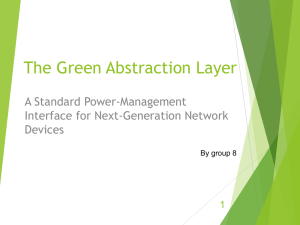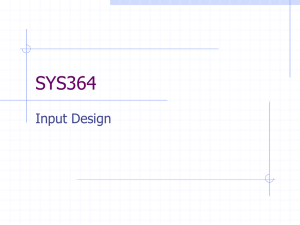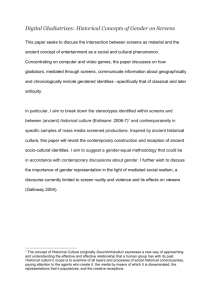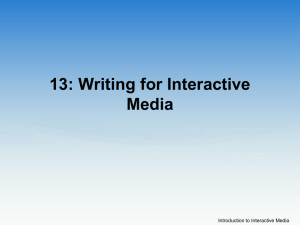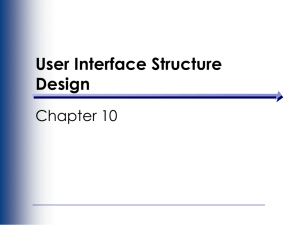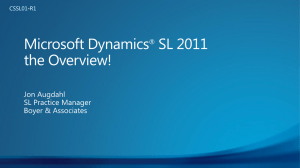The Potential for Energy-aware User Interfaces on Handheld Devices
advertisement
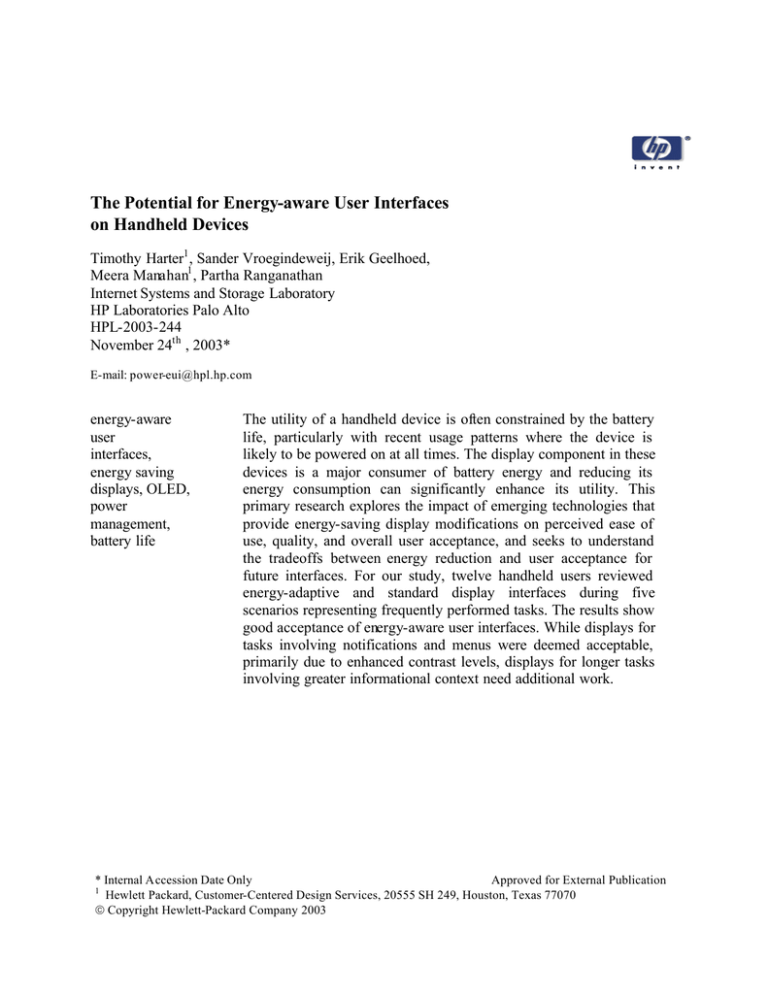
The Potential for Energy-aware User Interfaces on Handheld Devices Timothy Harter1 , Sander Vroegindeweij, Erik Geelhoed, Meera Manahan1 , Partha Ranganathan Internet Systems and Storage Laboratory HP Laboratories Palo Alto HPL-2003-244 November 24th , 2003* E-mail: power-eui@hpl.hp.com energy-aware user interfaces, energy saving displays, OLED, power management, battery life The utility of a handheld device is often constrained by the battery life, particularly with recent usage patterns where the device is likely to be powered on at all times. The display component in these devices is a major consumer of battery energy and reducing its energy consumption can significantly enhance its utility. This primary research explores the impact of emerging technologies that provide energy-saving display modifications on perceived ease of use, quality, and overall user acceptance, and seeks to understand the tradeoffs between energy reduction and user acceptance for future interfaces. For our study, twelve handheld users reviewed energy-adaptive and standard display interfaces during five scenarios representing frequently performed tasks. The results show good acceptance of energy-aware user interfaces. While displays for tasks involving notifications and menus were deemed acceptable, primarily due to enhanced contrast levels, displays for longer tasks involving greater informational context need additional work. * Internal Accession Date Only Approved for External Publication 1 Hewlett Packard, Customer-Centered Design Services, 20555 SH 249, Houston, Texas 77070 Copyright Hewlett-Packard Company 2003 The Potential for Energy-aware User Interfaces on Handheld Devices Timothy Harter1, Sander Vroegindeweij2, Erik Geelhoed2, Meera Manahan1, Partha Ranganathan2 Hewlett Packard Customer-Centered Design Services 1 20555 SH 249 Houston, Texas 77070 Hewlett Packard Hewlett Packard Labs 2 Palo Alto, USA Bristol, England Email: power-eui@hpl.hp.com ABSTRACT rapidly becoming one of the key markets of interest for computing systems. Since the batteries on these are typically limited in capacity, reducing the energy consumption is one of the key challenges in designing mobile handheld systems. The utility of a handheld device is often constrained by the battery life, particularly with recent usage patterns where the device is likely to be powered on at all times. The display component in these devices is a major consumer of battery energy and reducing its energy consumption can significantly enhance its utility. This primary research explores the impact of emerging technologies that provide energy-saving display modifications on perceived ease of use, quality, and overall user acceptance, and seeks to understand the tradeoffs between energy reduction and user acceptance for future interfaces. For our study, twelve handheld users reviewed energy-adaptive and standard display interfaces during five scenarios representing frequently performed tasks. The results show good acceptance of energy-aware user interfaces. While displays for tasks involving notifications and menus were deemed acceptable, primarily due to enhanced contrast levels, displays for longer tasks involving greater informational context need additional work. Among the various components that contribute to the consumption of electrical energy, the display subsystem (the electronics associated with the visual representation of the data generated by the system - namely the display and the controller) often plays an important role. For example, Choi et al. report that the display component of the system consumed close to 60% of the total power of the system for a handheld device [1]. Furthermore, unlike some of the other components of the system, display power consumption has traditionally been relatively invariant across technology shrinks making it a likely greater fraction of the total power of future systems. Current approaches to reducing display power consumption have either focused on aggressively turning off the entire display when it is not being used or resort to designing systems with lower-quality or smaller sized displays to minimize power. However, new, potentially better display technologies, such as Organic Light Emitting Diodes (OLEDs) [3], are becoming available that allow lower power consumption when a reduced area of the screen is in use. Based on the notion that different workloads and users have different display needs, these emerging displays can enable energy-adaptive designs that consume energy only on portions and characteristics of the screen that are being used by the application or are relevant to the user. Such designs have been shown to have significant energy savings (up to a factor of 10) for longer battery life in laptops [2]. Author Keywords Energy-aware user interfaces, energy saving displays, OLED, Power consumption ACM Classification Keywords H5.m. Information interfaces and presentation (e.g., HCI): Miscellaneous. INTRODUCTION The increased proliferation and acceptance of mobile devices with the handheld form factor (palm organizers, game players, cell phones, MP3 players) has led to their While such energy-adaptive designs lead to significant energy savings, they can typically include user-intrusive changes to the interfaces such as changes to the brightness, color, and on/off status of sub-portions of the screen. However, such changes to the user interface have not been formally studied for their user acceptance. In this work, we apply the notion of energy-adaptive designs to handhelds and explore the impact of energysaving user interface modifications on perceived ease of 1 use, quality, and overall user acceptance. To the best of our knowledge, this is the first work to evaluate energy-aware user interfaces compared to standard screens with users of handheld devices. Based on the insights from our study, we seek to understand the tradeoffs between energy reduction and user acceptance to identify task scenarios suited for such displays and to optimize future energy-aware interface designs. higher contrasts or graded dimming to turn off or dim (reduce the brightness) portions of the screen for lower power consumption. Table 1 shows the power reduction from the energy-aware user interfaces for each of the screens (the screenshots for the individual screens are shown in following sections). As shown in the table, the energy-aware user interfaces reduce the display power consumption anywhere from 22% -88% (factors of 1.3 to 8.3) relative to the standard interfaces. USER EVALUATION METHODOLOGY This section discusses the evaluation methodology of the user study we performed to compare energy-aware user interfaces with standard display interfaces. The primary objectives of this test were to evaluate the perceived quality and acceptability of energy-aware user interfaces for an OLED-based handheld design compared to standard handheld user interface designs. A secondary objective was to determine whether these factors were influenced by user type (consumer vs. business user). Scenario Power savings Notification 42% Today 74% Inbox 59% Message read 54% Reply menu 77% Reply-message 74% Scenario C Notes 88% Scenario D Book-read 80% Control menu 22% Battery check 24% Start menu 40% Scenario A Scenario B Participants Twelve advanced handheld users were recruited internally from within [our company]. Six participants used their handheld primarily for personal activities (consumers) and the other six used their handheld primarily for work activities (business users). All participants indicated they were concerned about battery life on their handheld, with 10 of 12 participants recharging their handheld at least once a day, and the other 2 recharging at least twice a day. Screen Scenario E Transitions Table 1: Power savings for energy aware screens, compared to standard screens Procedure The test consisted of two parts. In the first part, participants walked through various scenarios representative of typical day-to-day use of a handheld device. The scenarios were placed in the context of a user making a 90-minute train journey to meet a customer. The first scenario involved a mail notification enroute to the train station. The second scenario involved checking and replying to email in the train. The third and fourth scenarios involved note-taking and book-reading activities on the return journey back home, and the final scenario involved checking the battery life before re-docking the handheld for the end of the day. The study employed a within-subjects design, and the order in which the two sets of designs were viewed was counterbalanced across participants. Following each screen, participants filled out a series of quality ratings, which included ratings of text and characters, contrast and readability, on a 9-point scale, ranging from –4 (very bad quality) to +4 (excellent quality). The acceptability of these screens was also measured in rating scales, ranging from –4 (completely unacceptable) to +4 (completely acceptable). After walking through all scenarios on one set of screens, participants rated overall quality and ease of use and proceeded with reviewing and rating the second set of screens. The users were walked through the various scenarios with a set of screenshots representing the individual tasks in the scenario. The specific screens that the participants reviewed included a message notification screen, the “today” screen (the default screen), the today screen with the start-menu activated, an inbox screen, email message screens at different points in the scroll bar, a reply menu pop-up screen, a reply message screen, note-taking screens with and without text, acrobat reader screens of different pages in an e-book, a control-menu screen, and a battery-check screen. After completing all scenarios and filling out ratings for both sets of screens, participants completed a post-task questionnaire asking them to indicate the design they preferred most, to document three aspects of that design they liked, and to document the main reason they disliked the other design. In the second part, participants were debriefed about the energy saving capabilities of the energy-aware screens and asked to re-rate the energy-aware screens. Such data, collected after participants were made aware of the energy saving potential, is presented in the next section, when Two sets of screen shots were considered – one set representing standard interfaces and a corresponding set of screenshots representing energy-aware interfaces for the same handheld. The energy-aware designs typically used 2 significant. During this part of the test, participants were also presented with alternative energy-aware designs (shown in Figure 4 in the Discussion section) and asked a series of conceptual questions about potential energy-aware designs and future trends in handheld usage. Reply pop-up menu: The second set of screens, represented in figure 1, show the Reply Pop-up screens that test participants were requested to evaluate. Overall, the energy-aware design was rated high in quality and acceptability even before participants were made aware of its energy-saving benefits. Again, nine out of twelve participants commented that the added contrast between the pop-up message and the background on the energy-aware design makes the reply message more salient and easier to read than the standard design. Participant ratings showed that there was a statistically significant (p = .05) difference All the participants used a PocketPC handheld device for all the tasks and screens. Participants were encouraged to verbalize their thoughts and the study was videotaped for later review. The rating scale data were analyzed using repeated measures ANOVA (Analysis of Variance). RESULTS This section discusses the results from our user study. We examine each of the individual screens that participants viewed, and provide results of user preferences. Table 2 presents a summary and we refer to the relevant portions in our discussions of the individual screens below. For brevity, in Table 2, for the data on user ratings after the debriefing, we present results only for the screens where there were significant changes. As we can see from p-values in Table 2, the various screens can be broadly classified into (1) screens where the energyaware interfaces had higher acceptance compared to the standard interfaces, (2) screens where the energy-aware and standard interfaces had comparable acceptances, and (3) screens where the energy-aware interfaces had lower acceptance compared to the standard interface. Below we discuss these three categories in greater detail Data collected from consumers and business participants was collapsed and presented as one set, as there was only one factor of marginal statistical significance between the two user types. Energy-aware screens with high ratings Notificationstandard Notificationenergy-aware Reply pop-upStandard Reply popup Energy-aware Start MenuStandard Start MenuEnergy-aware Some of the energy-aware designs were rated to be highly acceptable, even preferable, in scenarios involving (1) Notification, (2) reply menu, and (3) start menu. The standard and energy-aware screens for these three cases are summarized in Figure 1. Notification: The first scenario presented to each participant involved display notifications. As seen from Table 2, overall, the energy-aware design was rated high in quality and acceptance even before participants were aware of its energy-saving benefits. Seven out of twelve participants said they preferred the energy-aware design to the standard design because the added contrast between the pop-up message and the background made the notification message more salient. There were no statistical differences between the standard and the energy-aware interfaces for quality of the screen or for its acceptability. Furthermore, probably due to a ceiling effect, there were no statistical differences in acceptability of the energy-aware ratings, after the test participants were informed of the energy saving benefits. Figure 1: Screen shots for screens with high ratings for energy-aware interfaces between the perceived quality of the standard design and the energy-aware (EA) design for sharpness and clarity of text and characters, although both designs were rated highly. However, the results indicated no statistically significant difference between the acceptability of the quality of the standard design and the energy-aware (EA) design before debrief. Both designs were rated positively for all measures with means greater than 3.00 for overall 3 acceptance. Furthermore, there were no differences in ratings after the participants were made aware of the energy savings benefits. able to read all the messages in their inbox and were confused about the purpose of the varying shades of gray. The results indicate a statistically significant difference does exist between the perceived quality of the standard design and the energy-aware design as well as its acceptance for all measures. Participants rated the standard design higher for all measures. All quality ratings for the Start-menu: The third display set involved reviewing menus to complete tasks. Although the Start Menu screens were not rated, all twelve participants reacted positively to the energy-aware design, most likely because the area of focus on the screen is highlighted. Energy-aware screens with moderate ratings The next set of screens included those where the energyaware interfaces got moderate ratings. These included (1) the Today screen, (2) Note taking, and (2) the battery check screens. Figure 2 shows the screen shots for these screens. Today screen: There were no statistical differences between the standard and energy-aware ratings for the Today screens, and both were rated highly. Several participants commented that the added contrast on the energy-aware design made the text more readable. Other participants, however, felt the darker background created a “depressing” mood. Five of twelve participants preferred the energy-aware screen with the all-black background to the dimmed background. In general, participants were not passionately opposed to the energy-aware design, but they preferred the brightness of the standard version for everyday use. Notes: With respect to the note-taking screens, there were no statistical differences in ratings between the standard and energy-aware ratings. Overa ll, the energy-aware screens were rated high in quality and acceptability before and after participants were made aware of its energy saving benefits. Power-control and battery-check: With respect to the power control screen, there was only one significant difference between the standard and energy-aware interfaces – in the rating of contrasts. Table 2 provides this result. Acceptability ratings were not significantly different. The energy-aware design of the battery check Screen was rated high in quality and acceptability before the debrief, and even higher after participants were made aware of its energy-saving benefits. These ratings were higher, and are presented in the “after-debrief” section of Table 2. Today Standard Today Energy-aware Notes-message Standard Notes Energy-aware Control menu Standard Control menu Energy-aware Battery check Standard Battery check Energy-aware Energy-aware screens with low ratings Scenarios involving (1) Inbox, (2) Message-read, (3) Replyto-message, and (4) Book-read were generally rated lower for their energy-aware interface compared to their standard interface. Figure 3 shows the screen shots for these interfaces. Inbox: Overall, as seen from Table 2, the energy-aware design of the Inbox Screen was rated low in quality and was unacceptable, before and after learning about its energysaving benefits. Participants complained about not being Figure 2: Screens with moderate ratings for the energyaware interfaces 4 energy-aware design were negative values. The energyaware design was rated negatively for all quality measures except for the acceptance of the sharpness and clarity of text and characters, which received a neutral rating. As seen from the “after-debrief” section in Table 2, the results indicated a statistically significant change in readability of the energy-aware design existed after the participants were made aware of the energy saving characteristics, although readability was still rated as unacceptable. No other significance differences existed. benefits (the statistical difference was now limited to only one metric) and liked the fact that they could still read all the text on the screen. Furthermore, several participants preferred the dark header on the energy-aware design to the standard version because the added contrast between the header and the body text helped divide the page more clearly. Several participants wanted the title bar at the top of the screen to be more visible. Acceptability ratings Reply-to-message: Overall, the energy-aware design of the reply-to-message screen was rated low in quality compared to the standard design. Participants complained about not being able to read the entire message without scrolling. As shown in Table 2, the results indicate a statistically significant difference does exist between the perceived quality of the standard design and the energy-aware design for all measures (p= .01 for all three ratings). Participants rated the standard design higher for all measures. Contrast level and readability both received negative ratings for the energy-aware design, while sharpness and clarity of text and characters was rated slightly positive. Acceptability ratings for these screens also showed a similar trend, with the standard designs being significantly rated better than the energy-aware designs. Furthermore, test participants did not change their ratings even after learning about the energy saving benefits. Book-read: These screens simulated reading a book on a handheld via Adobe Acrobat reader. Overall, the energyaware design of the Acrobat Reader Screen was rated low in quality and was unacceptable even after learning about its energy-saving benefits. Participants complained about not being able to read the entire text without scrolling. As shown in Table 2, the results indicate a statistically significant difference exits between the perceived quality of the standard design and the energy-aware design for contrast level and readability (p= .00 for both). The energyaware design received negative ratings for both contrast and readability while the standard design was rated more than three points higher for both. Acceptability ratings showed a similar trend and these ratings did not change after participants were made aware of the energy-saving capabilities. At the very end of the testing sessions, participants were shown lighter gray versions of these screens, and their reactions were more positive. This is discussed further in the next section. Message-read: The final screen to have significant differences was the message read screen. However, even though there were statistically significant differences between the perceived quality of the two sets of screens, overall, the energy-aware design of the Urgent message screen was rated fairly high in quality and acceptance even before participants were aware of its energy-saving benefits. Furthermore, as shown in the “after-debrief” results in Table 2, participants were even more accepting of the energy-aware design after learning of its energy saving Inbox Standard Inbox Energy-aware Book read Standard Book read Energy-aware Reply-to-message Standard Reply-to-message Energy-aware Message read Standard Message read Energy-aware Figure 3: Screens with low ratings for energy-aware interfaces 5 followed a similar trend. the value at which the design becomes unacceptable to users. One method would be to provide participants with a transparency bar or scrolling selection mechanism for the purpose of testing. Participants could be asked to adjust the level to their optimal setting and then to the setting at which the design becomes unacceptable to them. The percentage for these points can then be recorded and compared across participants. Most participants seemed open to the concept, but true usability cannot be determined without trying it on an interactive prototype. Moreover, several participants indicated the scrolling highlight was more acceptable for email tasks than for reading books or long documents. Thus, both these contexts should be tested to determine whether the scrolling highlight concept needs to be optimized for each of these tasks. DISCUSSION In addition to the data summarized in Table 2, at the end of the experiments, to help us better calibrate some of the trends, participants were shown several alternate versions of the screens and asked to qualitatively rate them. Some of the screens evaluated in this part are show in Figure 4. Looking at broad themes across our results, we find that in general, energy-aware user interfaces were accepted by users . The main wins were for notifications, start screens, pull-down menus, power-control tabs, and, more generally, areas with lower informational context. In many cases, the added helpful contrast led to energy-aware interfaces being preferred even without an awareness of the energy benefits. (The energy savings just for these cases is on average 53%.) In some cases, users were willing to tradeoff some personal preferences for longer battery life. However, our results indicate that the common themes that emerged from our study about user preferences can be leveraged for better interfaces with greater acceptance and energy savings. For example, the desire to see the contents of the entire screen, the desire to use brightness/contrast or color to highlight areas of interest, the desire to be able to personalize an interface, etc all lead to lower energy while improving the user experience. Screens for tasks involving a longer duration or requiring greater informational context that had low ratings used gradients for the high informational content. Gradients were used to highlight specific parts of the screen and gradually dim the rest. As seen from the differences between the Message-read screen and the other screens (Inbox, bookread, reply-to-message) and from our qualitative evaluation screens, extremely dark values of gray were unacceptable and lighter grays were more acceptable. The use of notification messages and other pop-up menus should be further developed to find new ways to integrate this feature throughout the OS. Our study suggests that popup designs may have larger implications than the context of saving energy. As previously mentioned, seven of the twelve participants preferred the notification and pop-up energy-aware designs to standard designs at first use. Further work (and a subject of our ongoing follow-up user study) needs to be done to determine the optimal level of gray for users. For example, several participants wanted the option to choose between three levels of energy-aware settings. In order to provide these choices, the range of acceptability needs to be determined by testing a variety of light to mid-gray values to find (at a reasonable estimate) Alternate Today Power savings: 88% Alternate Notes Power savings: 60% Alternate Inbox-1 Power savings: 33% Alternate Inbox-2 Power savings: 59% Alternate Book read Power savings: 44% Alternate reply-to-msg Power savings: 55% Alternate message-1 Power savings: 65% Alternate message-1 Power savings: 79% Figure 4: Screen shots of other interfaces qualitatively studied and their power savings compared to their corresponding standard interfaces 6 These types of messages may be an area to demonstrate added value for ease of use beyond the benefits of reduced power. Interactive versions of these designs should be tested for performance to determine whether usability of screens can be enhanced. Our results show that overall, energy-aware user interface designs were acceptable. In some cases, the energy-aware designs were rated to be highly acceptable, even preferable, in specific situations in which helpful contrasts were created. Participants who preferred the energy-aware designs cited improved contrast and more readable text as reasons they liked the new design. Participants who preferred the standard version cited too much darkness as the primary reason they disliked the energy-aware designs. Almost all participants preferred the energy-aware designs for pop-up messages (i.e. Notification Screen, Reply Pop Up Screen, Start Menu Screen) because the added contrast makes the pop-up more salient. Additional benefits such as increasing readability through added contrast should be incorporated in future design so that energy-aware technology can be implemented to improve usability instead of simply providing a tradeoff. For example, several participants noted that the scrolling highlight on the reading screens actually aided them in keeping their place. More of these opportunities should be identified to increase the acceptance of the overall energyaware designs beyond their primary purpose. Those screens in which greater context of information is required were not as well received by participants. For example, participants perceived the energy-aware design for the Acrobat Reader Screen to be extremely difficult for locating and understanding information than the standard design. However, at the very end of the testing sessions, lighter gray versions of the energy-aware designs were shown to participants and were unanimously preferred to the darker gray versions of the energy-aware gradients designs for all screens. Finally, although the Today screens used in this study were deemed to be acceptable by participants, they did not receive overwhelmingly high ratings or reactions – most participants simply said they could live with it. Since the Today screen is a very critical part of the OS, we highly recommend exploring more design options in the next test session. The response to the all black background design was encouraging, and this is an area worth exploring. The Today screen may also provide a forum for testing notification messages and other pop-up menus in the next test. Although participants were generally accepting of the black background for reading text in the note-taking screens, they had more doubts about writing on a black background. An interactive writing task should be tested using this same screen design in the next session. Another option might be to test an energy-aware design for the keyboard input. We are currently working on a follow-up user study that addresses the points raised in this section. Our work identifies that energy-aware interfaces can actually provide a good combination of energy benefits and greater ease of use by leveraging features that improve usability instead of simply providing a tradeoff. As part of ongoing and future work, we plan to further study these. Some of the common themes we identified from our participant responses include the desire to use contrast to highlight areas of interest, the desire to personalize an interface, and the desire to see a large amount of context at a given time. Some interesting areas of future research include the evaluation of greater use of notification-style interfaces that facilitate enhanced contrast, and a more detailed evaluation of grayness gradients, scrolling interfaces, and energy-aware configuration settings that maximize user acceptability. Going further, similar work needs to be done in user interfaces beyond displays to include other modes of communication with the user. Overall, we believe that such energy-adaptive user interface designs that facilitate greater user acceptance while concurrently optimizing for another metric of system interest such as battery life are extremely promising and are likely to become an important part of future mobile system designs. CONCLUSIONS As the usefulness of mobile devices is increasingly constrained by their battery capacities, it will be ever more important to optimize battery life by reducing the power consumption of individual components such as the display subsystem. Traditional user interfaces have not had to consider the cost of the design on energy or battery life, but have mainly focused on user acceptance. However, recent work with emerging technologies like OLEDs have shown significant energy savings (up to a factor of 10) in laptop display power by intelligent energy-aware user interface designs that control color and brightness of sub-portions of the screen. However, these studies have not evaluated the designs for user acceptance. REFERENCES Our work is the first study that, to the best of our knowledge, applies the notion of energy-aware user interface designs to handhelds and explores the tradeoffs between energy savings and perceived ease of use and user acceptance metrics. Focusing on common mobile scenarios with twelve handheld users, we evaluated user acceptance of energy-aware designs that achieved up to factor of 8 reduction in energy compared to traditional interfaces. 1. I. Choi, H. Shim, and N. Chang. Low-power color TFT LCD Display for Handheld Embedded Systems, In Proceedings of the International Symposium on Low Power Electronics and Devices, pages 112-117, August 2002 2. S. Iyer, L. Luo, R. Mayo, and P. Ranganathan. EnergyAdaptive Display System Designs for Future Mobile Environments, Proceedings of the First International 7 Conference on Mobile Systems, Applications, and Services, May 2003 Quality Acceptance Quality Acceptance Quality Acceptance Quality Acceptance Quality Acceptance Quality Acceptance Notification Measure Std Text/Chars 2.92 Contrast 2.67 Readability 3.08 Text / Chars 2.83 Contrast 2.83 Readability 3.42 Today Screen Text/ Chars 2.67 Contrast 2.58 Readability 3.00 Text / Chars 3.08 Contrast 2.75 Readability 2.83 Inbox Text/ chars 3.25 Contrast 3.25 Readability 2.75 Text/ chars 3.33 Contrast 3.17 Readability 3.33 Message Read Text/ chars 3.17 Contrast 3.58 Readability 3.25 Text /chars 3.25 Contrast 3.58 Readability 3.42 Reply menu Text/Chars 3.33 Contrast 2.83 Readability 3.00 Text/ Chars 3.17 Contrast 2.75 Readability 2.92 Reply-to-message Text/ chars 3.17 Contrast 3.25 Readability 2.83 Text/ chars 3.33 Contrast 3.25 Readability 2.92 EA 3.08 2.67 3.50 3.33 3.08 3.33 P-val .64 1.00 .14 .27 .61 .75 2.25 1.67 2.08 1.83 1.83 1.92 .64 .30 .25 .19 .30 .27 -0.42 -0.83 -1.67 0.00 -1.67 -2.00 .00 .00 .00 .00 .00 .00 1.42 0.92 1.17 1.58 0.67 1.00 .00 .01 .00 .01 .00 .00 2.92 3.42 3.33 3.08 3.00 3.42 .05 .29 .57 .78 .52 .37 0.50 -0.83 -0.58 0.25 -1.17 -1.17 .01 .00 .00 .00 .00 .00 3. Stanford Resources Inc., editor. Organic Light-Emitting Diode Displays: Annual Display Industry Report. Second edition, 2001 Quality Acceptance Quality Acceptance Quality Acceptance Notes Measure Std Text / Chars 3.00 Contrast 3.17 Readability 2.92 Text / Chars 3.08 Contrast 3.33 Readability 3.08 Book-read Text / Chars 1.33 Contrast 2.42 Readability 2.33 Text / Chars 1.67 Contrast 2.67 Readability 2.50 Battery check Text / Chars 3.50 Contrast 3.42 Readability 3.42 Text / Chars 3.50 Contrast 3.50 Readability 3.50 EA 2.50 2.58 2.33 2.58 2.17 2.33 P-val .49 .25 .40 .47 .09 .27 0.25 -1.17 -0.92 0.17 -1.50 -1.25 .25 .00 .00 .08 .00 .00 3.33 2.83 3.17 3.25 3.00 3.17 .44 .05 .34 .19 .08 .17 Data for screens that had significant changes after debriefing Inbox (after debrief) Metric Pre Post Text/chars 0.00 0.67 Acceptance Contrast -1.67 -0.08 Readability -2.00 -0.25 Message-read (after debrief) Text/chars 1.58 2.42 Acceptance Contrast 0.67 2.33 Readability 1.00 2.17 Battery check (after debrief) Text/chars 3.25 3.67 Acceptance Contrast 3.00 3.75 Readability 3.17 3.75 P-val .51 .12 .04 .12 .02 .08 .02 .01 .00 Legend: P-val: Values <= .05 are significant; Bolded values represent cases where P-value is significant; Std: default screen; EA: energy-aware screen Table 2: Summary of data from user study 8
